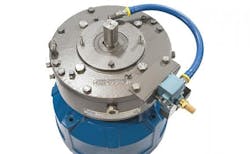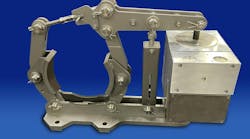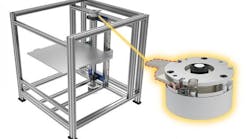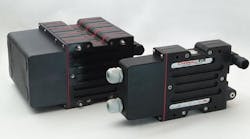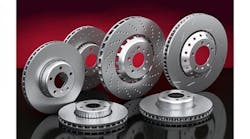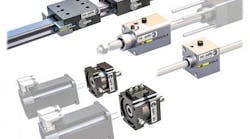Posistop Curing Press Brake Eliminates Maintenance and Adjustment
The Posistop CPB is a direct fit-in replacement to the currently used dry friction brakes mounted on the back of a motor used to open and close the NRM/McNeil mechanical curing press for tire manufacturing and retreading operations. Totally-enclosed Posistop CPB features Oil Shear technology which eliminates all the maintenance aspects of the dry friction brakes, including wear which leads to adjustment and replacement, and heat which causes degradation of the dry friction material, glazing, and torque fade, which also leads to adjustment, replacement, or failure. Air-actuated Posistop is also better suited for the wet, hot environments typical of tire manufacturing, than electrically actuated dry brakes which are prone to corrosion and linkage failure. Force Control Posistop CPB brakes are ideal for curing presses of all sizes and types.
Currently used dry friction brakes generate heat which degrades the friction material, reducing torque, glazing, and eventually failure. To make up for reduced torque due to wear on the friction plates, the brakes require frequent adjustment. If not adjusted, the coils will not release the brake, causing serious damage to the brake, or the motor. If brake torque fades too much, the stop will miss position, causing serious press damage. Constant actuation coupled with moisture and heat also causes the brake coil to fail. The numerous small linkages within the brake will corrode due to moisture, humidity, and chemical fumes causing the brake to hang up, yielding engagement and disengagement problems.
In contrast, the totally enclosed and sealed Posistop CPB keeps the oil shear fluid in and the dirt, oil, moisture, and chemical fumes out, eliminating those problems. During engagement, the transmission fluid transmits torque, and separates the friction discs and drive plates, thus eliminating virtually all wear. Because most of the work is done by fluid molecules in shear, wear is virtually eliminated as is the need for adjustment. As the pressure on the disc stack reaches a static condition, the brake becomes a static holding brake.
Heat, which causes many problems in dry braking systems, is eliminated by the transmission fluid which is circulated through the disc stack and back to the housing. The heat generated in the friction stack during stopping is carried to the housing to be cooled. The cooled fluid is then directed back into the stack to repeat the process. Since the transmission fluid acts as a lubricant, the bearings and splines are constantly lubricated, eliminating wear and early failure on these components.
The spring set, air-actuated Posistop is better suited to the wet, hot conditions typically found in tire plants, than electrical components used in dry braking. The air tends to cool, whereas electric actuation generates its own internal heat. The unique air-actuated piston system is designed to seal the piston for a long, maintenance-free service life. In addition to the O-rings used to seal the piston, Teflon liners are installed over the O-rings to keep them from rolling up and breaking. A severe duty cast housing is designed for industrial usage, and provides years of service before rebuild. A pre-plumbed and mounted air valve is included for quick response.
How Oil Shear Works
Unlike dry brakes, oil shear technology includes a layer of transmission fluid between the brake disc and the drive plate. As the fluid is compressed, the fluid molecules shear – thus imparting torque to the other side. This torque transmission causes the stationary surface to turn, bringing it up to the same relative speed as the moving surface. Since most of the work is done by the fluid particles in shear, wear is virtually eliminated. Elimination of wear also eliminates the need for adjustments which are common in dry braking systems.
In addition to transmitting torque, a patented fluid circulation system helps to dissipate heart which is a major problem with traditional dry brakes. Along with heat removal and torque transmission, the fluid serves to continually lubricate all components of the oil shear brake, elongating their service life.
